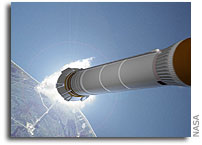NASA – Agency Has Taken Steps Toward Making Sound Investment Decisions for Ares I but Still Faces Challenging Knowledge Gaps, GAO-08-51

What GAO Found
NASA has been taking steps to build a business case–demonstrating the project is achievable within the constraints of time and money and other resources NASA has available–for Ares I. This has included relying on established technology and adopting an acquisition strategy that emphasizes attaining knowledge on cost, schedule, and technical and development feasibility before commitments are made to long-terms investments. The project also acknowledges that many risks are present and is undertaking an array of activities to track and mitigate those risks.
However, NASA has not yet developed the knowledge needed to make sound investment decisions for the Ares I project. Principally, there are gaps in knowledge about requirements, costs, schedule, technology, design, and production feasibility. Our work shows that successful program execution is dependent on having these elements in place at the time long-term investment commitments are made.
While NASA still has 10 months under its own schedule to close gaps in knowledge about requirements, technologies, costs, and time and other elements needed to develop the Ares I system, the gaps we identified are fairly significant and challenging given the complexity and interdependencies in the program. For example, continued instability in the design of the Orion Crew Exploration Vehicle is hampering the Ares I project’s efforts to establish firm requirements, the aggressive J-2X upper stage engine development schedule is not synchronized with the rest of the project, and it is unclear if NASA has allocated sufficient funding to the project.
Why GAO Did This Study
One of the first steps in the National Aeronautics and Space Administration’s (NASA) efforts to implement the President’s plan to return humans to the moon and prepare for eventual human space flight to Mars is the development of the Ares I Crew Launch Vehicle. In 2005, NASA outlined a framework for implementing the President’s plan and has awarded contracts for Ares I and the Orion Crew Exploration Vehicle it is designed to send into space. It plans to conduct the first human space flight in 2015.
However, the agency is seeking to speed development efforts in order to reduce the gap in our nation’s ability to provide human access to space caused by the Space Shuttle’s retirement in 2010. GAO was asked to assess NASA’s progress in developing the knowledge needed to make sound investment decisions for the Ares I project. GAO’s work included analyzing Ares I plans, contracts, schedules, and risk assessments.
What GAO Recommends
GAO recommends NASA establish a sound business case for Ares I before proceeding beyond preliminary design review (now set for July 2008), and if necessary, delay the preliminary design review until the project’s readiness to move forward is demonstrated.








